#gaulish polytheism
Text
hi yes hello
i'm an artist making apparel, accessories, and agitprop for queer pagans and metalheads who love nature and hate nazis







my most recent shop update also includes a pre-order window for these Hávamál 127 hoodies

in late july one of my cats had to be hospitalized and i'm still catching up on bills, so if my work resonates with you or someone you know, sharing would be much appreciated. thanks!
#cernunnos#heathenry#gaulish polytheism#norse paganism#queer artist#trans positivity#animism#witchcraft#paganism
544 notes
·
View notes
Text
My Drive Resource Libraries
Feel free to download, share, etc. I found most everything through open access journals, JSTOR, Anna's Archive, sci-hub, pdfs shared on other sns, etc.
Greek Polytheism & Hellenism
Roman & Italic Polytheism
Gaulish & Gallo-Roman Polytheism
Celtiberian Polytheism
#hellenism#helpol#cultus deorum#greek polytheism#polytheism#roman polytheism#gaulpol#gaulish polytheism#gaulish pagan#celtiberian
429 notes
·
View notes
Text
Pagan/Heathen/General Polytheist question: How do you feel that war deities, or deities associated with war, battle, and combat, for into modern Polytheist religions?
#heathenry#paganism#polytheism#heathen#pagan#polytheist#hellenic polytheism#brittonic polytheism#gaulish polytheism#roman polytheism#kemetic polytheism
389 notes
·
View notes
Text
Unpopular Opinion: The Gods would never let a trickster spirit claim to be them. Most religious people are not scared of malicious entities masquerading as their God(s). Have more faith that your Gods will take care of you.
#polytheism#polytheist#deities#pagan#deity#paganism#gaulish polytheism#roman paganism#greek mythology#roman mythology#trickster spirit#deity communication#deity work#spirit work#spirit communication#witchcraft#witchblr#paganblr#witch#witchythings#witchyvibes#necromancy#trickster#spirits
1K notes
·
View notes
Text
So as far as I'm aware in the Celtic umbrella of deities we don't have any deities SPECIFICALLY related to weaving/textiles or pottery. Which in the grand pattern of Indo-European branches (or even humanity as a whole) seems.... very odd...
What are the community's thoughts on these acts falling under the purview of Brigit or her other language counter parts? Are there other deities that would make more sense for these activities? What are our thoughts?
#gaelpol#gaelic paganism#gaelic polytheism#gaelic deities#celtic#celtic paganism#celtic polytheism#celtic deities#Irish#irish paganism#irish polytheism#irish deities#gaulish#gaulish polytheism#Gaulish paganism#Gaulish deities#brigid#brighid#brigit#bríg#bríd#*Brigantī#Brigantia#Brigindo
61 notes
·
View notes
Text

Credits to the wonderful people of NorthMyth on Etsy for their impeccable craftsmanship and speedy delivery. Support them, if you can. Ukrainian artists deserve our aid!
#statues#statuettes#woodcarving#woodcarvers#gods#pagan#pagan gods#gaulish pagan#roman gods#Gaulish#Roman#roman paganism#gaulish polytheism#roman polytheism#gallo roman#Gaul#Moccus#cernunnos#Epona#Sulis#Taranis#Janus#Ukrainian#ukrainian art#ukrainian artists#polytheism#paganism#Celtic#Celt paganism#celtic polytheism
140 notes
·
View notes
Text
The Horned Serpent
So before I get started on this one, I have a couple of things to get out of the way. First, I will be using she/her pronouns for the Horned Serpent; this is just because UPG and because I'm used to it. I know someone else who venerates/worships the Horned Serpent, uses they/them pronouns for them, and considers them to be beyond gender / present as whatever gender they feel like. Second, I will be focusing on my interpretation of her on the Gundestrup Cauldron, in part because there's really not a lot of literature on her, even when you include works that specifically analyze Cernunnos' depictions. Third (and related), I will be using the National Museum of Denmark's estimate as to when/where the Gundestrup Cauldron was made, which is roughly in the Danubian or Wallachian Plain(s) around 150 BCE to 1 CE (link).
So first a little historical & cultural context. This area, as far as culture groups, would have been a heck of a melting pot, between the Dacians and Thracians that already lived there, the Scythians coming in and also living near by, the Gauls that moved in around the 300s-200s, the Greeks who came up and started establishing colonies along the Black Sea in the 300s, and the Romans, encroaching on everyone's business around the time the Cauldron was built. A pretty solid primer on the history of the region is A Companion to Ancient Thrace, published by Wiley Blackwell.
So I'm gonna try to make sense but it might be a little disorganized going forward. Anyway, onto the actual thoughts & stuff. So anyone who's taken even a passing glance at Cernunnos is well aware of the Horned Serpent, since she is present in basically every ancient art you can find with him. On the Gundestrup Cauldron, she appears three times, all on the interior panels. One is at the Hero's heel, who's holding the wheel; a second is at the end of a line of heroic riders, which seems to be a Thracian horseman motif; and of course the famous Cernunnos panel. In Thracian Tales of the Gundestrup Cauldron, published by Najade Press, Jan Best presents an interpretation of the interior panels as a story, and assumes that Cernunnos is singing in his famous panel, specifically about the secrets of immortality, a concept which was very popular at the time. I agree with this and I also assume that the depiction of Taranis / the wheel god is that he is also singing, and if he is singing then the lions and griffins - both predators associated with kingship (griffins were protectors of the pharaoh, and also decorated certain tombs out in ancient Persia), then the action of passing off the Wheel must have symbolic meaning, such as being handed the Wheel of Heaven.
The Gundestrup Cauldron's exterior also has very clear influence from the Scythians, you can almost 1:1 map the gods based on Herodotus's retelling of the Pontic stories. I believe there are also thematic parallels going on here on the Wheel God panel, featuring a new god/king being given the symbol of his domain. Wikipedia actually has some relatively thorough articles on Scythian religion as well as the genealogical myth specifically, which is the myth that I personally associate with the wheel-giving panel. As well, the animals in this panel don't appear to be particularly concerned with attacking anyone - if anything, the griffins and lionesses are slightly tilted from one to the next, which makes me think it's more likely that they are dancing, especially if the human/divine subjects are singing, especially if the human with the helmet is receiving a high honor, potentially his rank amongst the gods. In this panel, she is just at the hero's feet, not really joining the parade if the animals, but clearly not ready to attack either, but her attention does seem to be drawn towards the hero.
The final panel she is on is the panel featuring the nine soldiers and the heroized dead, represented by the "Thracian horseman" motif. After Alexander the Great and his penchant for having statues of himself be on horseback, it became popular for wealthy men and nobles to depict themselves riding horseback to a goddess or sacred tree (unfortunately my best source discussing this in English is also not great and he comes up with some..... questionable theories), but the popularity seems to have blown up to the point where even deities such as Zeus were depicted on horseback in a similar manner. There are also mentions in a few other sources that the Thracians believed in the ability for people to essentially become immortal after death. Unfortunately, I'm having trouble sorting out my notes and this essay has been nagging me for weeks now.
Anyway, I interpret this panel as what is expected to happen to us after we die - the "ordinary", so to speak, are lead to a deity, likely to be reincarnated (this is honestly just a guess on my part largely due to the popularity of that in Greece for ever, and Grecian influence was in full swing by the time the Cauldron was made), meanwhile the "extraordinary" are lead by the Horned Serpent.
This is where I tie all three together to my upg/theology: The Horned Serpent is a friend and ally to Cernunnos. He teaches the secrets of life after death to those who will listen. The Horned Serpent is by his side during his teaching, and when we die, if we have proven ourselves worthy during life, she guides us through the trials of the afterlife. If we succeed in these trials, we are awarded with apotheosis - becoming a god or godlike - and she stands by our side as we earn this prize.


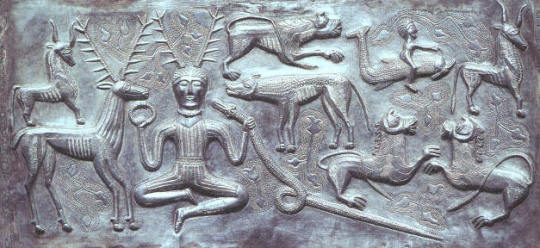
@musingmelsuinesmelancholy sorry it took me so long x.x & I hope this makes sense!
#cernunnos#thracian polytheism#gaulish polytheism#dacian polytheism#scythian polytheism#the horned serpent#balkan paganism#celtic paganism#paganism
19 notes
·
View notes
Text
With all of the depictions of Cernunnos these days as this hulking, bearded, muscle-clad macho man who lives in the woods, it's very easy to forget that the single major depiction we have of him looks like this:

Image description begin: The engravings on the Gundestrup Cauldron, depicting a male-ish figure with noodle arms holding a torc in the right hand (image left) and a snake in the left hand (image right). There are deer of some kind on the left side of the image, and some strange dogs on the right side of the image. End image description.
I mean...

Image description begin: The same image, zoomed in to the face of the figure. The mouth is partially open, the eyes are looking slightly forward, and the nose is very flat. It overall looks very goofy. End image description.
#i love deer dad but let's not forget that the gundestrup cauldron exists#jasper post#shitpost#deity work#gaulish#gaulish paganism#gaulish polytheism#cernunnos#cernunnos god#cernunnos deity
170 notes
·
View notes
Text
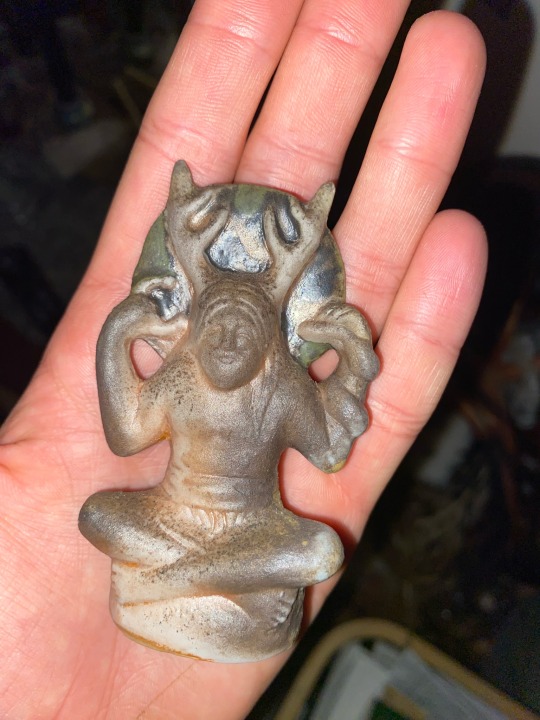
The smallest God
Made by magickdeerystudio; hopefully when the Selkies Pearl opens back up for the season I can check out her stuff in person!
As if I wasn’t pleased enough with this little Carnonos, him being created by a local artist just makes it all the more special
I plan on commissioning her to create a piece for Tsirona and Melusine
23 notes
·
View notes
Text
Cernunnos e offering

#cernunnos deity#cernunnos god#Cernunnos#celtic polytheism#celtic mythology#celtic paganism#celtic witchcraft#celtic#paganism#gaulish paganism#gaulish#gaulish polytheism#gaulish pagan
13 notes
·
View notes
Text


The Reims Stela (Autel de Reims) is one of the more impressive and complete survivals of Cernunnos iconography.
Because the weathered stone is so dull, I've always wanted to see it restored to its former polychromy glory — so I experimented with some digital colorization!
#reims#cernunnos#polychromy#polytheism#paganism#gaulish#horned god#mercury#apollo#aedicula#pagan altar#gaulish polytheism#roman polytheism
10 notes
·
View notes
Text
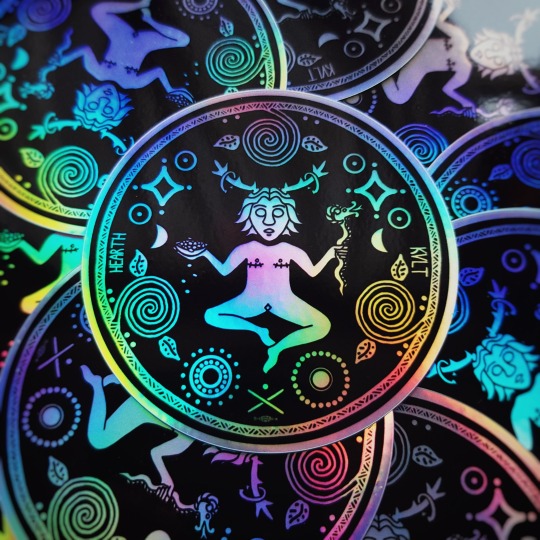
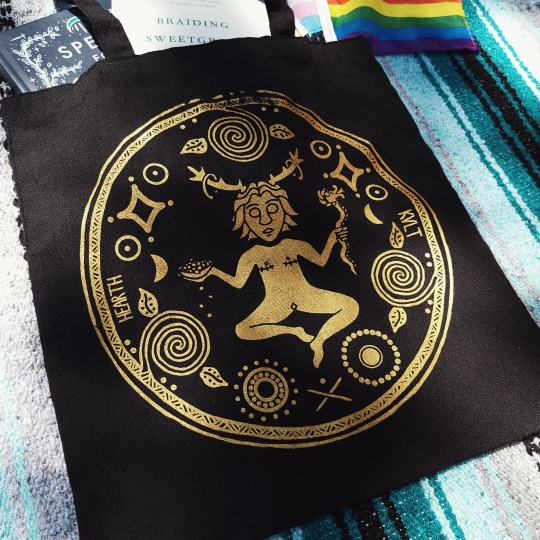
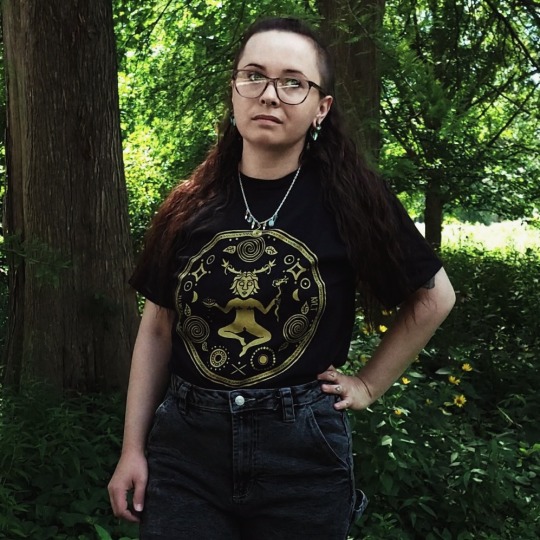
a couple of weeks back i shared this piece called Generosity of Spirit, featuring a transmasc figure styled after Cernunnos along w/ decorations from iron age coins and the Anglo-Saxon rune "gyfu," meaning "gift"; it's currently available on union-made holo stickers, and pre-orders are open til friday 7/14 for totes and t-shirts (S-4X). rejoice in some prehistoric he/they bussy
ps: wall art is slated for september
71 notes
·
View notes
Text

The Celtic goddess Sequana in her duck-boat.
Bronze, Gallo-Roman era, Archaeological Museum of Dijon
#cultus deorum#celtic#celtpol#gaulpol#gallo-roman#archaeology#roman archaeology#celtic art#sequana#polytheism#gaulish polytheism#gaul#oh she comin#the duck is holding a ball in its mouth#also the boat is LITERALLY a duck#it doesnt get better than this my friends
109 notes
·
View notes
Text

An emissary of Sirona reminds you that a sliver of healing and peace awaits you wherever there is rushing water. The springs await you.
Sirona (Đirona) is a Continental Celtic (Gaulish) goddess who was worshipped across Europe, from the east of France all the way to Hungary. She is associated with snakes, healing springs, wells, and stars, which also provides the origin of her name (and there's also an asteroid named after her, fittingly). Under Roman interpretation, she was associated with Diana and was often seen as a consort of Apollo. Temples and plaques were dedicated to her along healing springs.
#art#snake#tw: snake#polytheism#paganism#gaulish polytheism#continental cletic#gaulish paganism#sirona#devotional#artists on tumblr
375 notes
·
View notes
Text
(SOLD)- Chaplet of Sirona



snake vertebrae, moonstone, fossilized coral
A chaplet dedicated to the dewoi of stars, springs, and healing, Sirona. Worshipped by the continental celtic people, the goddess Sirona was petitioned for miracles of health. Contemporarily, Sirona is often viewed as an ouranic and ocean dwelling dewoi, so this double tailed and winged mermaid amulet felt the perfect fit to depict the goddess.
Sirona's traditional attributes of the serpent and basket of eggs, the venom and the remedy, are represented here by snake vertebrae and milky white moonstones. The fossilized coral is meant to represent her connection the waters, and I hand picked specimens which reminded me glittering stars in all their many hues.
This piece, completed under the full moon, was blessed with lunar oils (as I am among those Gauls who see Sirona as a lunar-spirit), and other appropriate stellar materials. A prayer recited over each bead as it was passed over a fumigation of mugwort.
$78
#gaulish polytheism#rosary#pagan rosary#witchcraft#pagan#gaulish#moon goddess#star goddess#ocean goddess
9 notes
·
View notes
Text
Attended a sound bath ritual with guided meditation and Reiki healing. In many cultures, caves are chthonic symbols and spaces of liminality. I brought my Cernunnos Totem because caves are a symbol of his domain.


I hope you enjoy my video & photos. More to come.
#deities#pagan#polytheism#polytheist#deity#paganism#gaulish polytheism#witchcraft#witchy#chthonic#Cernunnos#Horned god#the horned one#the horned god#meditation#sound bath#caves#celtic mythology#mythology#hedge witch#witch#witchlife
57 notes
·
View notes